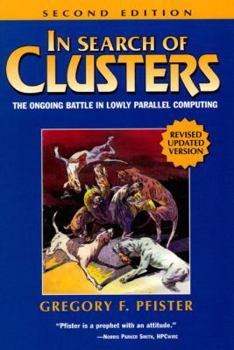In Search of Clusters
Select Format
Select Condition 
Book Overview
As Microsoft's much-touted "Wolfpack" Cluster Server shows, clustering technology has arrived in the marketplace. Clustering is now a strategic direction for Microsoft, Compaq, IBM, Sun, DEC, Novell,... This description may be from another edition of this product.
Format:Paperback
Language:English
ISBN:0138997098
ISBN13:9780138997090
Release Date:January 1997
Publisher:Prentice Hall
Length:608 Pages
Weight:1.65 lbs.
Dimensions:1.3" x 6.1" x 8.9"
Customer Reviews
5 ratings
good technical overview of systems architectures
Published by Thriftbooks.com User , 22 years ago
This book provides a terrific introduction to the hardware, software, and systems architecture of parallel computing, candidly discussing the issues and trade-offs in various approaches. The emphasis is on clusters, but there is lots of information on the whole continuum from single processor machines to SMPs to clusters to distributed computing. Pfister will leave you with a better understanding of things like how SMP machines keep processor caches coherent, what the differences are between SMP, NUMA, and distributed computing, how various cluster products work, real world cluster issues (like system administration), programming models used in parallel computing, and why programming code that runs efficently on these architectures is usually the hard part.The book is somewhat dated - nothing about Beowolf for example - but the concepts remain valid. Many of the issues are illustrated with reference to mainframe clusters, especially IBM's 390 sysplex, which I found particularly interesting since I don't have much experience with these systems.The style is highly readable and informal, but not insultingly non-technical. The book is loaded with opinion and insights - it is not a dry textbook of issues related to clustering. Highly recommended for anyone in the business of creating information systems that need to run fast.
This is the Clustering Bible
Published by Thriftbooks.com User , 24 years ago
As other reviewers have said, this is an excellent book and is a *must have* for anyone exploring practically any aspect of cluster computing. Even beyond the quality of the information conveyed, the writing style is wonderful and the author makes an otherwise abstract and cumbersome topic quite readable and quite approachable. This book is regarded as the Clustering Bible worldwide, and I've seen copies placed prominently in the bookshelves of individuals in Beijing, Tokyo, Paris, and the US. Microsoft's own Cluster Server was codenamed 'Wolfpack', as an honerable reference to the cover art of this specific book. Aaron McKee Clustering Products Manager TurboLinux Inc.
An exemplar of how to write a readable technical book
Published by Thriftbooks.com User , 24 years ago
Other reviewers, both publishers and individuals, have already said many good things about this book. Believe them all. There's plenty of meat for the greying professional yet it's accessible (and enjoyable) to the relative neophyte.The author has been compared to Scott Adams. While his style is eminently readable, I think this may not entirely do it justice: I'd be more inclined to liken his ability to present detailed concepts in an approachable manner to that of Richard Feynman - though as a non-neophyte with an intense interest in the subject matter my evaluation may be biased.If you have an interest in high-performance, high-availability processing and/or SANs (whether you call them 'storage area networks' or 'system area networks'), there may well be no better single source of information. If you simply have an interest in computers in general, you could just read it for fun.
Concise, timely and humorous description of OS technology
Published by Thriftbooks.com User , 26 years ago
The revision, like the Original is fresh and engaging - offering complex technical concepts in bite sized, palatable parcels. Mr. Pfister has done something wonderful for the computer industry with this book. The term clustering has been miss used and miss understood, often with drastic consquences, since Digtal released VMS V4.0 (and within clustering) and UNIX vendors tried to copy it. Greg Pfister has done a level set, defining terms and concepts and than comparing each implementation's strengths and weaknesses with a unique blend of clarity and humor. I recommend this book for 3 camps: I consider it classic example of how to write a technical book, it is helpful for anyone wanting to develop or exploit reliable systems and it is a must read for folks considering or already involved with NT server Enterprise Edition.
A great book - A new standard for technical writing!
Published by Thriftbooks.com User , 26 years ago
Mr. Pfister with humor and clarity has explained scalability. His book is insightful, clear and an excellent introduction to the benefits of clustering (that is working together) both in terms of hardware and software. His revision updates the industry and keeps pace with one of the fastest moving arenas of computing.




